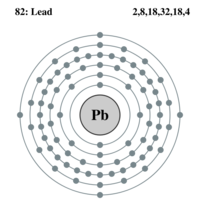Difference between revisions of "Lead"
(→Notes) |
|||
| Line 15: | Line 15: | ||
These mussels have a detoxifying mechanism for lead; they can store large quantities as granules (solid form) in their digestive gland (an organ that helps digest food). However, environmental concentrations above 10 ppm are shown to be detrimental for the growth of some organisms (some crustaceans and algae species).<ref name = c>Clark, R,B., 1999. Marine pollution. Oxford University press, Fourth edition, pp 161</ref> Other sublethal effects of too high lead concentrations that have been demonstrated include: anemia, reduced egg-hatching, fin degeneration and behavioural abnormalities.<ref name = ken>Kennish, M. J. (1996): Practical Handbook of Estuarine and Marine Pollution, CRC Press 524 pp</ref> | These mussels have a detoxifying mechanism for lead; they can store large quantities as granules (solid form) in their digestive gland (an organ that helps digest food). However, environmental concentrations above 10 ppm are shown to be detrimental for the growth of some organisms (some crustaceans and algae species).<ref name = c>Clark, R,B., 1999. Marine pollution. Oxford University press, Fourth edition, pp 161</ref> Other sublethal effects of too high lead concentrations that have been demonstrated include: anemia, reduced egg-hatching, fin degeneration and behavioural abnormalities.<ref name = ken>Kennish, M. J. (1996): Practical Handbook of Estuarine and Marine Pollution, CRC Press 524 pp</ref> | ||
| − | Like most other metals lead doesn't show [[biomagnification|biomagnifying]] characteristics. As a consequence it is normally of little harm to fish eating [[pollution and marine mammals|mammals]] or [[pollution and sea birds|birds]]. However, a rare incident of lead poisoning has occurred along the birds wintering on the Mersey estuary, near Liverpool. 2400 birds, mainly dunlins, died in 1979. The birds had 10 ppm ([[wet weight]]) of trialkyllead (an organic form of lead, which is more toxic) in their liver. Factory discharges caused lead to accumulate in the bivalve ''Macoma | + | Like most other metals lead doesn't show [[biomagnification|biomagnifying]] characteristics. As a consequence it is normally of little harm to fish eating [[pollution and marine mammals|mammals]] or [[pollution and sea birds|birds]]. However, a rare incident of lead poisoning has occurred along the birds wintering on the Mersey estuary, near Liverpool. 2400 birds, mainly dunlins, died in 1979. The birds had 10 ppm ([[wet weight]]) of trialkyllead (an organic form of lead, which is more toxic) in their liver. Factory discharges caused lead to accumulate in the bivalve [http://www.marinespecies.org/aphia.php?p=taxdetails&id=141579 ''Macoma balthica''], the primary food for these birds. <ref name = c>Clark, R,B., 1999. Marine pollution. Oxford University press, Fourth edition, pp 161</ref> |
| − | |||
== Case studies == | == Case studies == | ||
Revision as of 07:45, 31 August 2009
Definition of lead:
Lead is a heavy metal with symbol Pb and atomic number 82[1]. It has a bluish white colour, when freshly cut, but tarnishes to dull gray when exposed to air. It is also highly malleable[2]
This is the common definition for lead, other definitions can be discussed in the article
|
Notes
Anthropogenic use of lead in metallic from (battery casings, lead pipes) are usually recycled. But, lead used as petrol additives are largely lost to the atmosphere. This lead enters the marine ecosystem globally though rain. However coastal areas, with a lot of near shore automobile activity, can have considerably higher lead contamination. [3] The reduction of leaded gasoline in the last decades caused the surface concentrations of lead in the North Atlantic surface waters to decline between 1981 and 1989 with 50%[4].
Compared with other heavy metals, lead in the sea isn't particularly toxic. Its toxicity is also mostly determined by its chemical form, lead bound to organic compounds is much more toxic than inorganic lead[4]. So can some organisms accumulate high concentrations of inorganic lead without any apparent harm. In polluted areas barnacles can accumulate up to 100 ppm (parts per million) and mussels in Norway have been shown to contain up to 3000 ppm of lead. These mussels have a detoxifying mechanism for lead; they can store large quantities as granules (solid form) in their digestive gland (an organ that helps digest food). However, environmental concentrations above 10 ppm are shown to be detrimental for the growth of some organisms (some crustaceans and algae species).[3] Other sublethal effects of too high lead concentrations that have been demonstrated include: anemia, reduced egg-hatching, fin degeneration and behavioural abnormalities.[4]
Like most other metals lead doesn't show biomagnifying characteristics. As a consequence it is normally of little harm to fish eating mammals or birds. However, a rare incident of lead poisoning has occurred along the birds wintering on the Mersey estuary, near Liverpool. 2400 birds, mainly dunlins, died in 1979. The birds had 10 ppm (wet weight) of trialkyllead (an organic form of lead, which is more toxic) in their liver. Factory discharges caused lead to accumulate in the bivalve Macoma balthica, the primary food for these birds. [3]
Case studies
Heavy metal content of mussels in the Western Scheldt estuaryCommon starfish can act as a bioindicator for heavy metal pollution
Heavy metals in various Belgian benthic invertebrates
Environmental standards and legislation
Included in the OSPAR list of substances of priority action
Included in the water framework list of priority substances
See also
OSPAR background document on lead
References
- ↑ http://en.wikipedia.org/wiki/Lead
- ↑ http://glossary.eea.europa.eu/terminology/concept_html?term=lead
- ↑ 3.0 3.1 3.2 Clark, R,B., 1999. Marine pollution. Oxford University press, Fourth edition, pp 161
- ↑ 4.0 4.1 4.2 Kennish, M. J. (1996): Practical Handbook of Estuarine and Marine Pollution, CRC Press 524 pp
